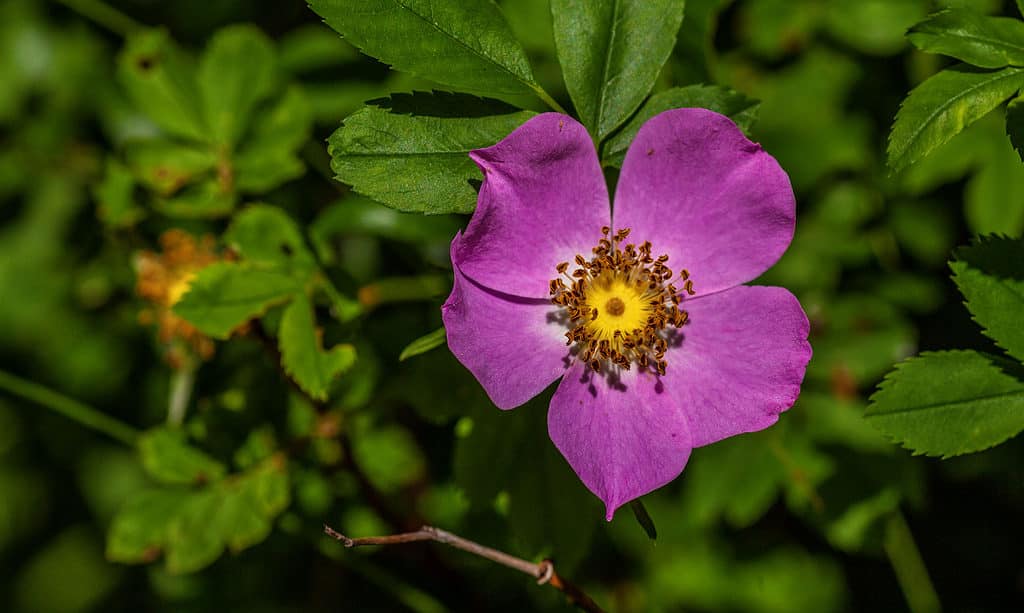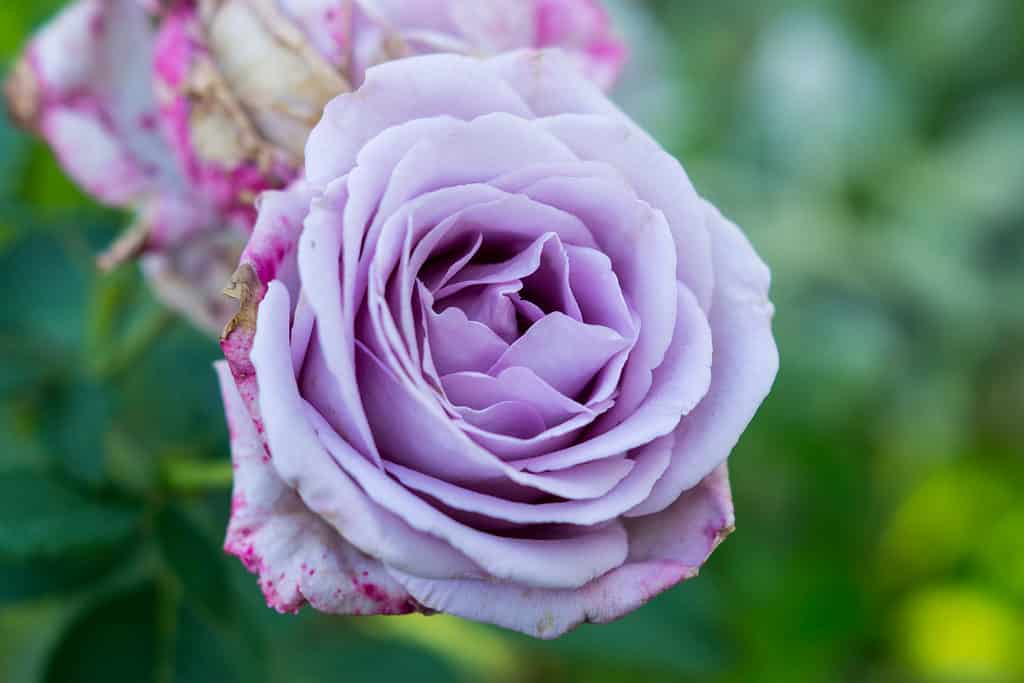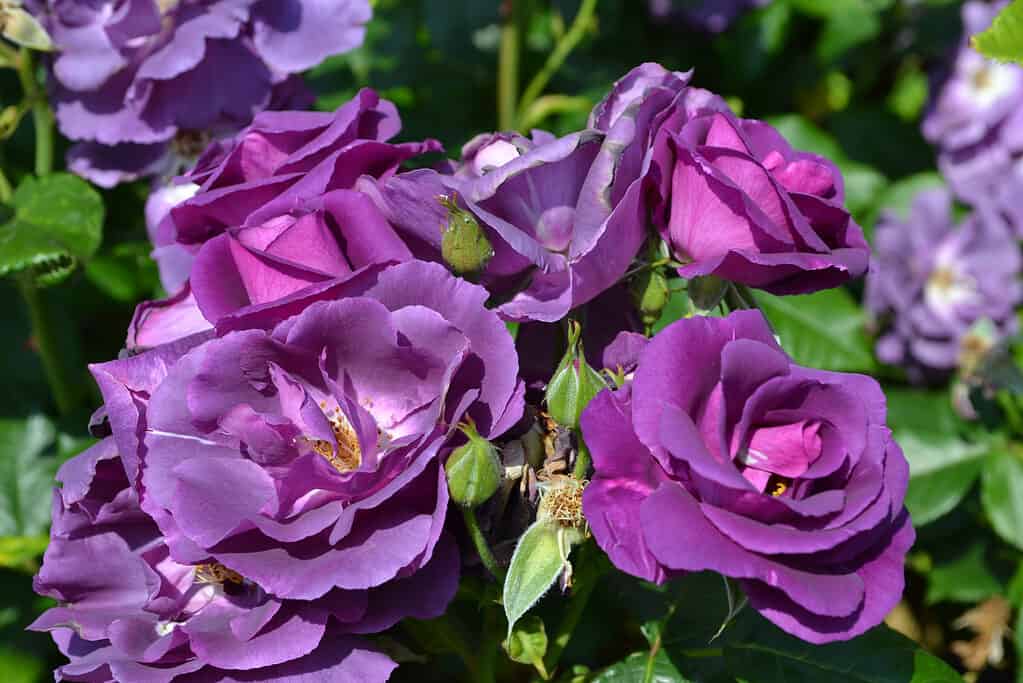Purple roses are rare and lovely flowers that have long been connected to affluence and regal status. These lovely flowers are still a common option today for weddings and other special occasions, as well as for giving to very special people in one’s life. In fact, it’s said that giving someone a bunch of purple roses conveys one’s deepest love for another person.
Purple roses make excellent additions to indoor spaces, gardens, landscaping projects, and more. There are a few different varieties of roses out there, and we’ll cover them in this guide. Along with our top picks for purple roses, we’ll also explore some interesting facts about purple roses that can make growing these unique beauties even easier.
The History Of Purple Roses
Purple roses, as their name implies, bloom in purple, lavender, and lilac hues. Purple roses are uncommon and prized since the flower kingdom doesn’t naturally include many flowers with these colors. They are an enjoyable and stimulating task for breeders and hybridizers. They stand for majesty, regality, and mysticism as presents and decorations.
Hybridizers likely created the earliest purple roses in the 1800s by breeding Chinese and European roses together. Innovative rose breeding allowed for the creation of several hues of purple because roses already possessed the natural colors of red, pink, yellow, and orange. Later, violet, plum, and lavender petal hues also emerged.
These magnificent blossoms were enthusiastically appreciated and quickly became prominent among people looking for uncommon flower hues. There are more hues than ever before, yet purple roses are still a favorite.
Identifying A Purple Rose
Purple roses are not a particular variety of roses; they are a color hybrid. Let’s take a quick look at the colors and tones of purple roses before we explore the several types and varieties of rose plants that produce purple flowers.
Purple roses’ hues range from dark, intense purple-red to pale, airy violet. When discussing purple or lavender roses, we typically mean flowers that are more pink or grey-lavender in hue. They need a lot of light, water, well-draining soil, and trimming on a regular basis, like nearly all roses.
When To Plant Purple Roses
Late May to early autumn is the ideal time to grow purple roses. The ideal time to plant your newly acquired plants from a nursery or garden shop is late April. You may plant rose bushes whenever they are in bloom as long as you maintain them well-watered and manicured.
Getting a clipping from a parent plant is the simplest technique to propagate and start growing purple roses. Remove the leaves of a newly cut stem before dipping the end into a rooting compound. Submerge two-thirds of the stem in top-notch, permeable soil. Keep the soil wet and keep the cuttings out of direct sunlight. New roots might take as long as a year to form. Since there is no assurance that all of the cuttings will take, it is advisable to plant more than one.

Wild native purple roses (pictured) exist but can be difficult to find.
©iStock.com/Vincent Ryan
The Meaning Of Purple Roses
The most popular occasions to offer these lovely roses include birthdays, anniversaries, Mother’s Day, Valentine’s Day, and romantic occasions. Purple and other purple flowers generally represent high honor, success, and monarchy. Others may think that purple flowers signify a mature or intense romance. Since most purple flowers, such as violets, lilies, and purple hydrangea, are in bloom in the spring, lighter colors of purple flowers frequently denote the season. Purple flowers also have a deeper connotation; they are frequently linked to enlightenment, mysticism, and inward exploration.
Roses in the lavender variety might signify magic and mysterious love. A rose with no thorns signifies love at first sight. If your rose is a deeper shade of purple, it can stand for enduring love and be given as a gift for your 25th wedding anniversary. Additionally, it stands for sophistication, richness, and elegance.
Types Of Purple Roses
The classic purple rose bush plant is the hybrid tea rose. Each stem of these erect rosebushes bears a substantial bloom. Hybrid tea roses are known for their long stems, which makes them perfect cut roses for hand-tied bouquets and fresh flower arrangements. Compared to other varieties of landscape flowers, hybrid tea rose bushes often require more upkeep. Neptune, Blue Moon, and Blue Nile are purple hybrid tea rose types.
Small single to double-bloom clusters are produced by floribunda roses. Three to 15 blooms can be seen in each flower cluster. This purple rose bush plant is extremely thick and has a mounding, shrub-like look. Floribundas typically mature at heights between two and three feet with an equal spread, being on the smaller side. Purple floribunda rose cultivars, including Angel Face, Ebb Tide, and Burgundy Iceberg, fall within this category.
Hybrid tea roses and floribunda roses are crossed to create grandiflora roses. The huge blooms are formed like hybrid tea roses and appear at the end of each stalk as both single blooms and clusters. Compared to hybrid teas, the stems are shorter than those of floribunda roses. The grandiflora rose shrub may reach a height of six feet. Purple grandiflora rose varieties include Fragrant Plum, Melody Parfumee, and Wild Blue Yonder.
Purple Rose Varieties
1. Indigoletta Rose
Botanical Name: Rosa ‘Azubis’
Originally known as the Blue Queen, this rose is sometimes referred to as the Azubis rose. The Indigoletta rose is a wonderful feast for the eyes when it presents its gorgeous blossoms in June, with its dark, leathery leaves and lilac-colored petals. The purple rose is a fantastic addition to any garden because of its consistent profusion of blooms far into fall, and its heady scent tempts you to daydream. The plant’s robust growth and lush foliage are further traits. This hybrid tea rose has 17 to 25 petals per double bloom and a strong aroma.

The Indigoletta rose (pictured) does best in hardiness zones five through nine.
©Vita Sorokina/Shutterstock.com
2. Neptune Rose
Botanical Name: Rosa ‘WEKhilpurnil’
Gardeners love the Neptune rose’s large, delicious lavender flowers with a little hint of purple. The profusion of blossoms appears on a praise-worthy plant with huge glossy green leaves, high strength, and powerful vitality, making it certain to win honors. Neptune is just as powerful as his namesake, despite his appearance of being mild and fragile. Neptune’s frosty lavender hue is tinted with just a bit of purple and blooms the largest five to six-inch blossoms in chilly temperatures. It has around 30 petals, which sparkle against the big, glossy green foliage. Neptune is a robust perennial bloomer with a light citrus and rose aroma.
3. Blue Moon Rose
Botanical Name: Rosa ‘Blue Moon’
Blue Moon was developed in France as one of the earliest lavender-blue hybrid tea roses. It features long, pointed buds that unfold into stunning, completely double flowers with more than 35 petals that measure an average of four inches in diameter. Blue Moon, a Sterling Silver ancestor, with a strong scent and extremely erect, robust growth. This remarkable rose is a need for any garden because of its gorgeous lilac flowers and exquisite smell. This rose is a fantastic continuous bloomer and thrives best in USDA hardiness zones five through 10. This rose also has a strong fragrance.
4. Big Purple Rose
Botanical Name: Rosa ‘STEbigpu’
This rose is a bit more fuchsia or mauve than purple, but it is still purple enough for this list. This gorgeous rose is one of our favorites, first for its vibrant color and then because it has a scent that fills the room even if you can’t see it. Large, leathery-leafed flowers ranging in color from mauve to violet red are produced on tall, stiffly erect stems. It is highly tough and resists corrosion, mildew, and black spot. It is recommended to grow this rose in the spring for a summer flowering season, and it thrives in USDA hardiness zones six through 10.
5. Rhapsody in Blue Rose
Botanical Name: Rosa ‘Rhapsody in Blue’
The Rhapsody in Blue Rose draws attention with its distinctive blue-violet blossom color; this is not surprising considering that it is now regarded as the “bluest” rose ever. Its white center, which emphasizes the striking floral coloration, increases its attraction yet more. Additionally, the Rhapsody in Blue Rose benefits any bed due to its mild scent and ability to withstand heat and rain. Expect this rose to grow three to four-inch blooms with up to 15 petals each in clusters. This rose makes a particularly good bouquet-cut flower and does best in USDA hardiness zones six through 10.

Rhapsody in Blue roses (pictured) can either have a bluish or purplish hue.
©Edita Medeina/Shutterstock.com
6. Blue Rambler Rose
Botanical Name: Rosa ‘Veilchenblau’
The rambler rose known as Violet Blue, or the Blue Rambler rose transforms the garden once a year with its magnificent blooms and delectable mild smell. The rose is particularly beautiful right now since its buds are either sparkling white or a delicate lilac color, while its outer leaves are a rich purple color. With a towering height of up to 16 feet, this rose variety is also the undeniable highlight of the garden. However, the attractive blossom is not just noticeable from a distance; the rose is distinguished by its sturdy nature and aggressive development. The cultivar is also practically thornless, making it appropriate for gardens with children and pets.
7. Mainzer Fastnacht Rose
Botanical Name: Rosa ‘Mainzer Fastnacht’
The Mainzer Fastnacht rose features a bloom color that is absolutely exceptional: a delicate violet hue that almost seems silvery gives the lovely rose a distinctive appearance. The plant shows itself as a genuinely fashionable eye-catcher that understands how to steal the stage thanks to its light green leaves deftly. On the other hand, the “Mainzer Fastnacht”® captivates with its delightful aroma and good health in addition to its attractive aesthetics. However, if you’re considering buying the Mainzer Fastnacht rose, keep an eye out for it, as it’s also sometimes incorrectly labeled as a Blue Moon rose.
8. Novalis Rose
Botanical Name: Rosa ‘Novalis’
The bedding rose Novalis, which is also sold under the name Poseidon, combines lavender blossoms with high hardiness, earning it the right to carry the ADR predicate. The Novalis rose also enchants its elegance, which is further emphasized by its beautiful double blooms and subtle scent, thanks to its slender, tall growth and dark green leaves.
How delightfully unique are these purple roses? Rare, stunning, and absolutely gorgeous, these rose varieties will look lovely in any garden, be it a rose collection or a simple walkway garden with trellises. And if these varieties don’t suit your aesthetic, there are even more purple rose varieties out there to try.
Summary Of 8 Types Of Beautiful Purple Roses
| # | Rose | Color |
|---|---|---|
| 1 | Indigoletta Rose | Lilac-colored with lush foliage |
| 2 | Neptune Rose | Lavender, purple-tinged blooms with huge, glossy leaves |
| 3 | Blue Moon Rose | Lavender-blue double blooms |
| 4 | Big Purple Rose | Mauve to violet-red on long stems |
| 5 | Rhapsody in Blue Rose | Blue-violet blossoms |
| 6 | Blue Rambler Rose | Rich purple with violet to white buds |
| 7 | Mainzer Fastnacht Rose | Delicate silvery violet hue |
| 8 | Novalis Rose | Lavender blossoms with dark green leaves |
The photo featured at the top of this post is © iStock.com/danderson107
Sources
- NCSU Staff, Available here: https://plants.ces.ncsu.edu/plants/rosa/
- Sheryl Geerts, Available here: https://www.bhg.com/gardening/flowers/roses/ultimate-rose-care-guide/
- Abby George, Available here: https://gardender.com/purple-roses-the-5-most-beautiful-varieties-from-lilac-to-purple/
FAQs (Frequently Asked Questions)
Do purple roses exist in nature?
Purple roses do not exist in nature. They are hybrid roses and can also simply be white roses that have been dyed.
Do lavender roses exist in nature?
While some pink roses may have an almost lavender tint, purple roses in general do not exist as wild flowers.
What do purple roses symbolize?
Purple roses are often a symbol of love at first sight.
Thank you for reading! Have some feedback for us? Contact the AZ Animals editorial team.






